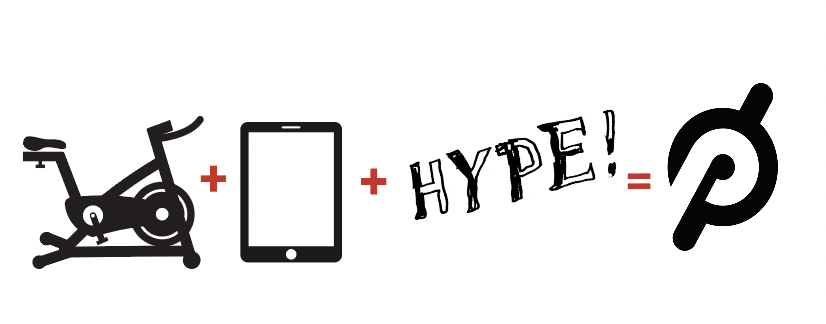The Cult of Peloton
Devotees made a stationary bike company rich—for a while
Things about me: I’ve never read Harry Potter books, I haven’t watched one second of Succession and I’ve never had a milkshake with half of a chocolate cake sticking out of it. I’m not big on hype.
Not to be a contrarian, but I hate being told what to do. I like to find things organically or preferably have The Rock whisper them into my ear: “Buy my Teremana tequila, Vonetta.”
So, I’d never hopped onto a Peloton indoor exercise bike. First, I live in an apartment that doesn’t have a well-lit solarium like the ones in Peloton ads. Also, I hate exercise.
When I found out my mission for this month’s article was to join in on the fitness fanaticism, I had concerns. Can a $2,500 Peloton bike live up to the hype? Have my friends and family joined a Peloton cult? And where can I buy padded shorts?
Those and other questions aside, let’s delve into the fitness craze that is Peloton.
Kickstart my heart
Peloton, the most successful Kickstarter venture of all time, listed its original bike for $1,500 on the crowdfunding site in 2013 and managed to raise $307,332. Most companies buckle under the weight of the hype on Kickstarter (looking at you, Coolest Cooler), but Peloton cranked up its resistance wheel and got stronger. It reached “unicorn” status in 2017 and went public in 2019.
When gyms had to close because of COVID-19, Peloton offered a way to get fit at home. The company’s market cap reached nearly $50 billion in February 2021, up from its $7 billion in October 2019. From Q2 2020 to Q2 2021, the company gained over one million new subscribers.

The flywheels fall off
Soon, however, Peloton began to struggle under the weight of its own growth. Delivery times went from days to weeks to months.
Then, in March 2021, a pediatric fatality occurred on its Tread+ treadmill. At first, CEO John Foley refused to address the issue, but the company eventually relented and issued a recall.
By last summer, vaccine adoption and gym reopenings prompted Peloton to slash prices. That hurt its bottom line, and Peloton’s stock closed out 2021 more than 75% lower than its December 2020 high.
In 2022, the company added hundreds of dollars in fees for its products as it grappled with waning demand. Then, in January 2022, news leaked that Peloton was temporarily halting production amid a companywide hiring freeze.
CEO Foley was again adamant that it wasn’t true, but weeks later under pressure from activist investors, Peloton fired Foley and eliminated 2,800 jobs, or 20% of its workforce.
The new CEO, Barry McCarthy, is the former CFO of both Netflix and Spotify, two low-priced subscription companies. Some think the only way forward is to sell the company. Peloton’s market cap as of this writing is $9.47 billion.
You’re just my hype
Here’s an update of an old joke: “How do you know someone owns a Peloton? Wait five minutes and they’ll tell you.” According to the site The Business of Apps, 66% of Peloton users are between the ages of 25-44, and 21% make over $200,000 a year.
Reasons for owning a Peloton differ, according to my friends and family members. “I’m a sucker for the latest and greatest exercise equipment,” Robyn M. told me. “I had a NordicTrack back in the day.” She’s motivated by Peloton’s live classes and toils to earn badges for taking classes and achieving goals.
Robyn isn’t alone. Beth F. told me this: “Love the product but love the personalities behind it even more. It really does feel like they share everything with you. You feel a connection to the product.”
Among the owners I interviewed, most admitted to following at least one of Peloton’s 51 class instructors on social media outside of the Peloton platform.
Users love the flexibility of creating their own workouts, finding a trainer they vibe with and being able to choose music that suits their personality. They also enjoy the ability to do non-cycling activities like strength training, boxing and yoga with the app—all for a $39 monthly subscription.
Drinking the Kook-Aid
Finally, the time had come to try the greatest fitness phenomenon since Suzanne Sommers wanted us to have thighs that could crack walnuts. Using a with the unlikely name of called pelotonbuddy.com (wish I was making that up), I found hotels in Chicago that had Pelotons in their fitness centers. I checked into one of them with a gallon of water, some padded booty shorts and a ring light.
My first class was a 30-minute hip-hop ride with popular instructor Kendall Toole. This class was a “replay” of her live class, but 20 people attended, even though it was late on a Thursday night. Kendall is blond, jacked and basically a spandex-covered gym treat. She’s her own perpetual motion machine and alternates between pithy motivational sayings, “You can rock this!” to the more banal “I’m excited for your journey!” Um, journey? I’m in a hotel gym during a blizzard.
Is the Peloton craze a spandex-covered cult?
It was easy to adjust the bike for my height and how close I wanted to be to the bars. The large HD screen was great for seeing all the action, and it displays your metrics. The bike’s seat, however, haunts me to this day. Go to Home Depot, find a 2×4, lay it across some sawhorses and then straddle it. That’s how the seat of a Peloton bike feels. Even though I had padded shorts, my butt hurt for days after my ride.
Like a lot of people, I haven’t been working out as much as I did before the pandemic. The class was challenging (why are we standing up now?), and my Apple Watch thought I was having a cardiac event, but I completed it. I was waiting for some revelatory experience, but I just took my wobbly legs back to my room to shower and sleep. I’d try more classes tomorrow.
The next day, I decided to try some of Peloton’s off-bike offerings. I did a 10-minute chest and arms class with Callie and a 10-minute shut up and squat (not sure if that’s the real name) with the chocolate Adonis known as Adrian Williams. I liked the off-bike classes better than the bike, but additional mats, weights and a screen that pivots all require extra cash.
Worth it?
True believers don’t like being told their deeply held convictions are their “opium,” but I don’t quite see what all the Peloton hype is about. Questions about the company’s future remain unanswered: Will they allow Netflix? Will Nike buy them out? Will the seat ever be comfortable?
But the company has built a dedicated base of fans who love the product and don’t use it for a clothes rack. The new CEO has hinted at a lower cost of entry or additional products that would democratize fitness.
But is Peloton a spandex-covered cult? I’m not going to go that far because the fan base is ripped and I’m an out-of-shape comedian. Just bring padded shorts and an open mind.
Vonetta Logan, a writer and comedian, appears daily on the tastytrade network and hosts the Connect the Dots podcast. @vonettalogan





















